Bees are a crucial part of the food chain as they help pollinate our crops, fruits, and vegetables. They also provide us with lips-smacking honey that no other creature can.
But how can we attract bees to our garden?
The simple answer is by planting bee-friendly flowers and plants.
But what plants can attract bees towards themselves?
In this article, we shall discuss the 15 best plants and flowers that can attract bees to your garden and backyard. We will also go through their basic care routine.
Lilacs
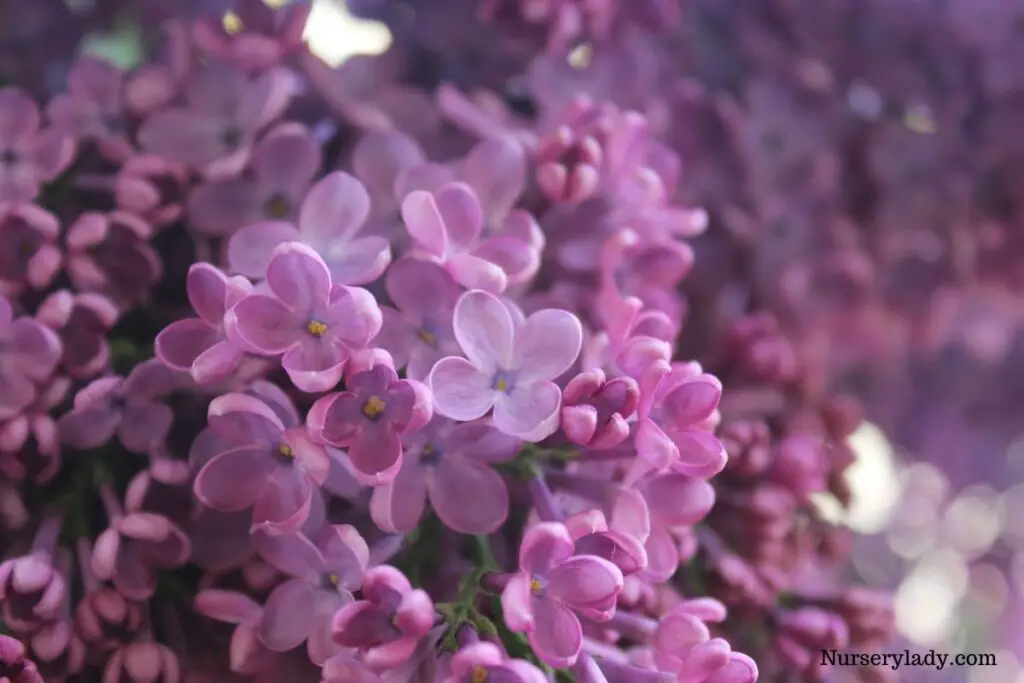
Lilac is an attractive plant grown as a focal point in living areas, landscapes, etc. They have gray-green leaves around 5 inches long, and they have a moderate growth rate and bloom during spring. Its color and fragrance make bees come back again and again.
Sunlight: Lilac is a sun-loving plant, so keep them in sun exposure for the whole day for best growth. They can grow in low light too, but their blooms will decrease.
Watering: Keep watering lilac when the soil is halfway dry but do not keep the soil in standing water. They can tolerate short periods of drought.
Fertilizer: Feed lilac in spring with a balanced fertilizer by diluting it to half the strength. They do not appreciate over-fertilizing as it can burn their roots and affect growth.
General care: Lilac likes cool temperatures and low to average humidity. They are cold hardy but will appreciate some protection from cool winds. Plant them in the loamy, well-draining soil mix. Prune the branches after flowering is over to promote blooming.
Lavender

Lavender is a beautiful plant with gray-green leaves and flower spikes, looking great with other flower plants like a rose. Its growth rate is moderate and tolerates a variety of conditions. They are rich in nectar, due to which bees buzz around them.
Sunlight: Lavender grows well in direct sun. To grow bushier and bloom well, keep them in a spot where they can receive 6-8 hours of light. Do not grow them near trees or any shade as it will inhibit their growth and bloom.
Watering: Lavender should be watered properly when planted to help them establish roots. Once established, they are drought tolerant and can bear long drought periods. Avoid too much watering as it can lead to fungal disease, etc.
Fertilizer: Lavender has no feeding requirements except adding compost when planting them. Feeding will rather deter their growth and blooming.
General care: Lavender is a hardy plant that can live in different temperatures. It is highly suggested to keep them away from dampness of any sort due to excess watering or high humidity. Please keep them in good airflow and protect them from harsh winds in winter. Add a mulch layer when the frost arrives to protect the roots.
Wisteria
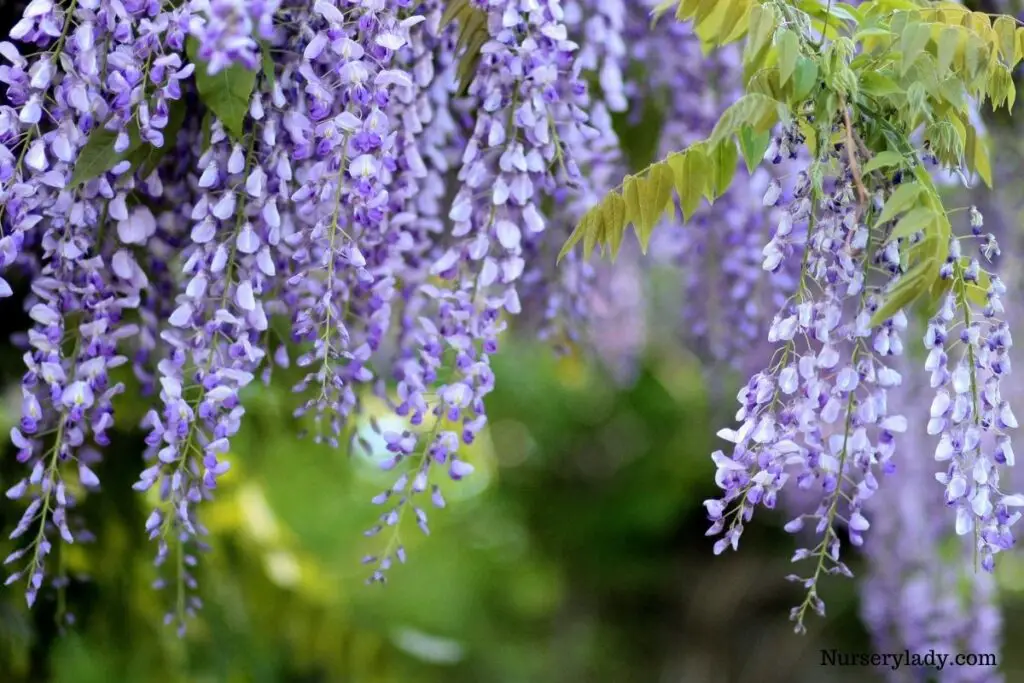
Wisteria is an attractive climbing vine that dazzles the eyes with its blooms. It needs proper care to be looking like that and to trail over other plants, objects, etc. It has a delightful fragrance and also charms bees. They are used to fill landscapes, even grow well in containers.
Sunlight: Wisteria to produce abundant blooms needs abundant light exposure. Please keep them in full sun or partial shade to have better growth. Also, create structures like a pergola to receive enough light and create a focal point.
Watering: Water wisteria properly in the first year of planting them to allow them to establish strong roots. After that, they need supplementary watering when completely dry.
Fertilizer: Feed wisteria with low nitrogen food once in the spring. They will do well even without fertilizing, and Over-fertilizing can hinder their growth and bloom.
General care: Wisteria likes cool to warm temperatures but may suffer in extreme heat. Prune properly after blooming to promote reblooming.
Mint
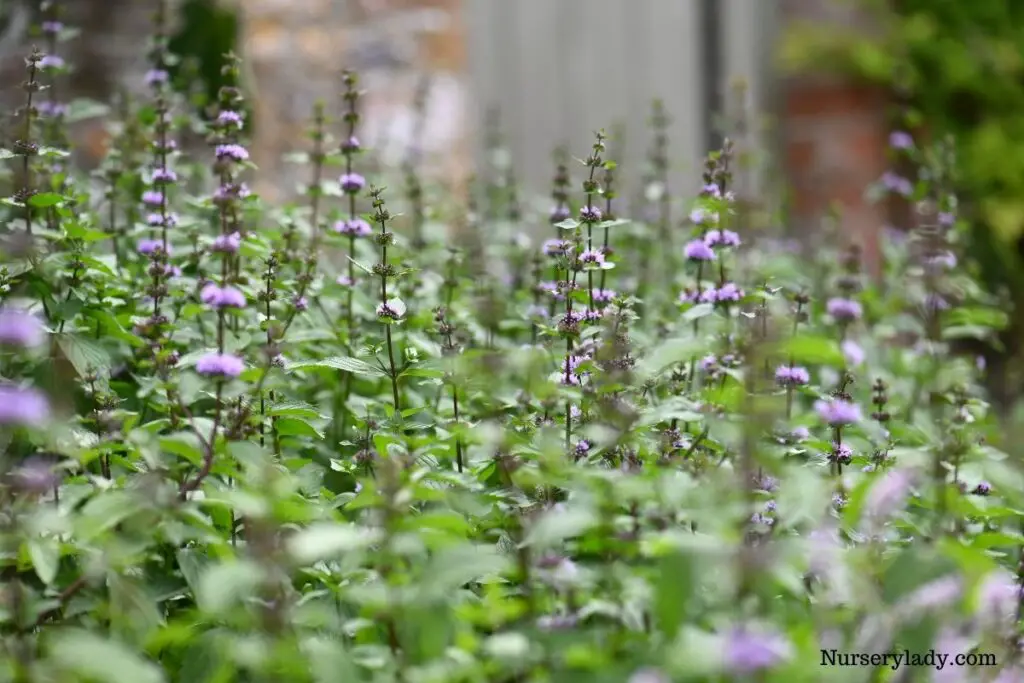
Mint has square stems, opposite foliage, and small white flowers. It has an aromatic fragrance, grows rapidly, and attracts bees, butterflies, etc. It spreads aggressively, even stems touching the soil will root and grow more.
Sunlight: Mint likes some shade but will grow in full sun too. When grown in the full sun, keep a check on their watering needs. The best lighting for them is an indirect bright light which is not harsh for the plant.
Watering: Water mints when its soil is completely dry. Keep the soil evenly moist for a bushier mint plant. Water them frequently when the sun is too strong to avoid wilting.
Fertilizer: Mints can be fed with a balanced fertilizer only if the soil is poor. If the soil is rich, there is no need to fertilize.
General care: Mints are tolerant to a wide range of temperatures. They are cold hardy, and even tolerate hot temperatures. Keep them in average to high humidity to avoid any struggle. You can mist them to raise humidity during dry months.
Looking for gardening supplies? We have tested 100's of products before recommending them to you guys. Check out our best pick below:
| Image | Gardening Supplies | Best Price? |
|---|---|---|
 Top
Top Top
Top | Raised Garden Bed Kit | Check On Amazon |
 | XLUX Soil Moisture Meter, Plant Water Monitor, Soil Hygrometer Sensor for Gardening, Farming, Indoor and Outdoor Plants, No Batteries Required | No Results |
 Top
Top Top
Top | 82 Pcs Garden Tools Set and Extra Succulent Tools Set | Check On Amazon |
 | Joeys Garden Expandable Garden Hose with 8 Function Hose Nozzle, Lightweight Anti-Kink Flexible Garden Hoses, Extra Strength Fabric with Double Latex Core, (50 FT, Black) | No Results |
 Top
Top Top
Top | Dual Chamber Compost Tumbler | Check On Amazon |
 Top
Top Top
Top | Sunnyglade Plant Stakes | Check On Amazon |
 Top
Top Top
Top | Organic Cold Pressed Neem Seed Oil | Check On Amazon |
 Top
Top Top
Top | Mighty Mint Gallon :-Insect and Pest Control Peppermint Oil | Check On Amazon |
 Top
Top Top
Top | Scotts DiseaseEx Lawn Fungicide | Check On Amazon |
 Top
Top Top
Top | Jacks Classic 20-20-20 All Purpose Fertilizer | Check On Amazon |
 Top
Top Top
Top | 30,000 Seeds Pollinator Attracting Wildflower Mixture | Check On Amazon |
 Top
Top Top
Top | Survival Vegetable Seeds Garden Kit-Over 16,000 Seeds | Check On Amazon |
Sunflower
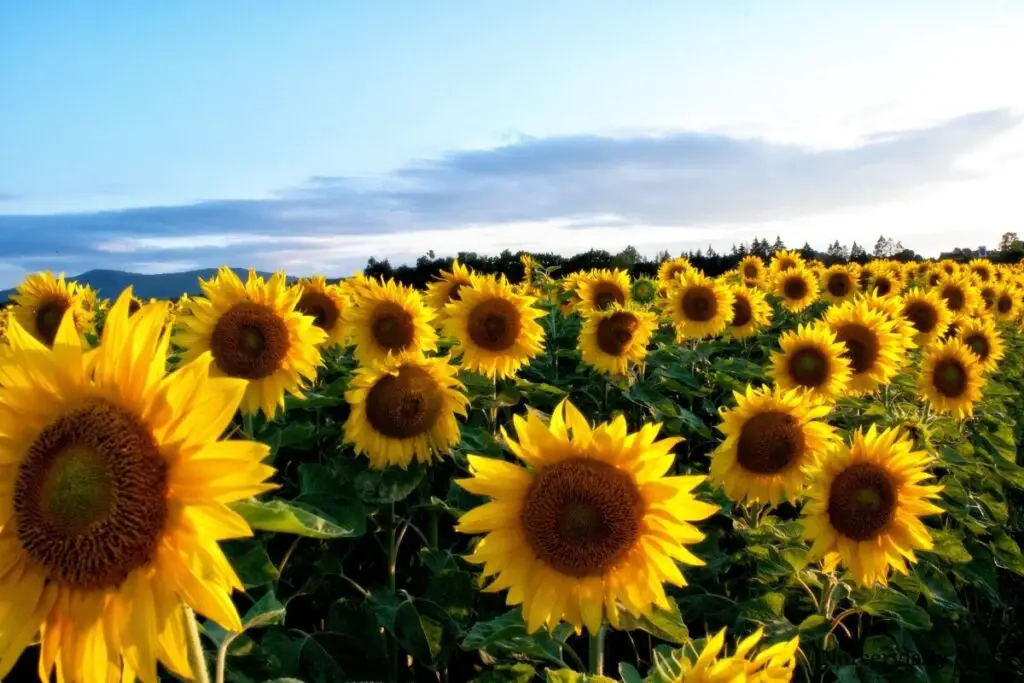
Sunflowers are famous flower plants with bright yellow blooms. They turn their heads towards the sun’s movement. There are abundant varieties of sunflowers, and you choose from the species that fits your conditions. They are good for bees as they produce ample pollen.
Sunlight: Sunflowers thrive in full sun. Grow in 6-8 hours of direct light and see abundant blooms. Find a sunny spot indoors or outdoors for your sunflowers.
Watering: Sunflowers like to be watered but should not be kept soggy. Sogginess will invite fungal diseases, root rot, etc. Water when the soil is halfway dry.
Fertilizer: Sunflowers need food to thrive. Feed them with a slow-release fertilizer or can add compost to improve the soil’s nutrient content. Avoid fertilizing too much as it can burn their roots.
General care: Keep your sunflowers in a safe spot in strong winds. Shelter them during hot and cold harsh winds. They thrive in temperature levels between 70 degrees Fahrenheit to 80 degrees Fahrenheit.
Poppies
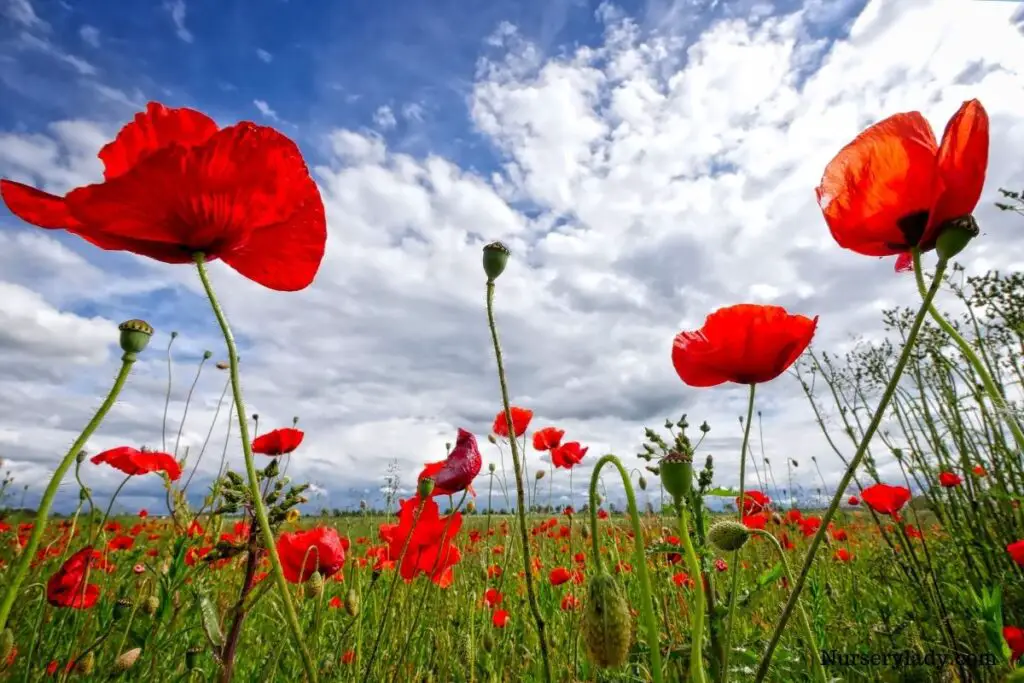
Poppies have large blooms in red, orange colors. Both their green leaves and flowers are attractive. They greatly contribute to medicinal use, crafting, food, etc. They are a great source of pollen for bees.
Sunlight: Poppies like a sunny location. Keep them in full sun to promote flowering and growth. Also, it will save the plant from powdery mildew infestation, which they generally catch.
Watering: Water poppies when the soil is dry and avoids overwatering. During their flowering season, water infrequent intervals when the soil is halfway dry. Sogginess can lead to root rot, fungal diseases, etc.
Fertilizer: You can feed poppies with a slow-release fertilizer. Feed them during the spring. You can also side-dress its soil with compost or manure instead of fertilizer.
General care: Poppies are cold-hardy plants and may suffer from high heat and humidity. You can apply mulch around the plant to protect them from winter. Use stakes in areas of high winds and protect from harsh wind.
Black-eyed Susan
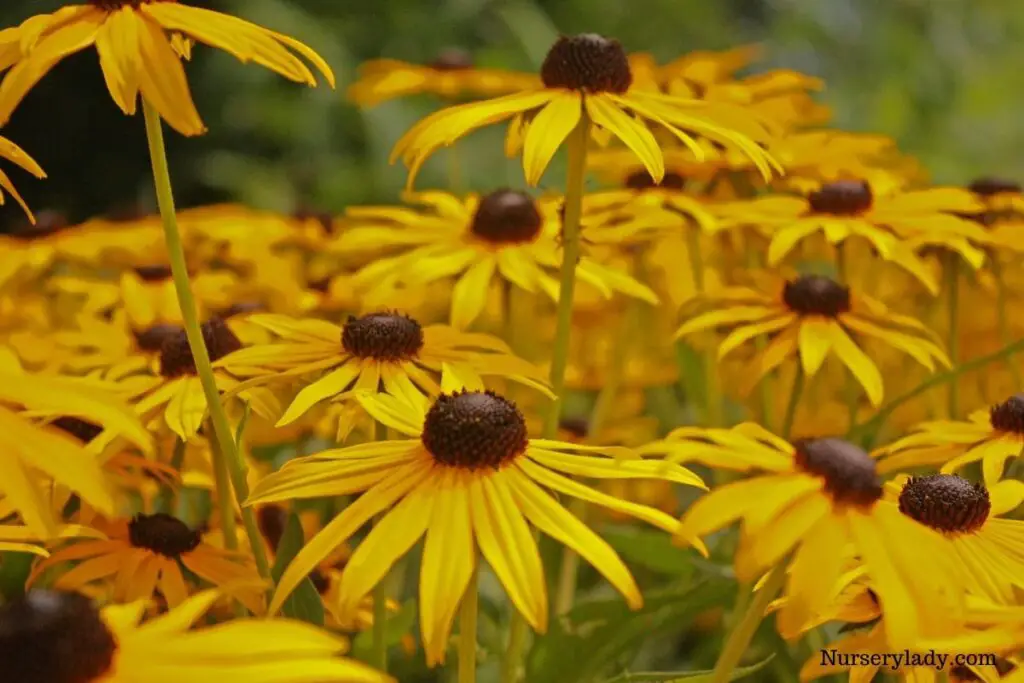
Black-eyed Susan has bright yellow flowers with a dark center. They have hairy leaves and look beautiful due to their flowers. It takes a few years to reach its full height. Bees like to feed on their nectar and keep buzzing around them. They self seed and create abundant wildflowers in your garden.
Sunlight: Black-eyed Susan grows and blooms best in full sun. They need bright light to fully. In low light, their blooming will be affected.
Watering: Water your black-eyes Susan in regular intervals in the first season for strong roots. After that, they become quite drought-resistant. Ensure proper drainage and never let the soil drown in water.
Fertilizer: Black-eyes Susan doesn’t need feeding to thrive. Too much can even affect their growth and lead to weak plants. Simply top dress or side-dress the soil with compost in the growing season.
General care: Black-eyed Susan’s flowers should be deadheaded to allow longer and better blooming. They like warm temperatures around 60 degrees Fahrenheit and more. They can thrive in low to high humidity.
Dandelions
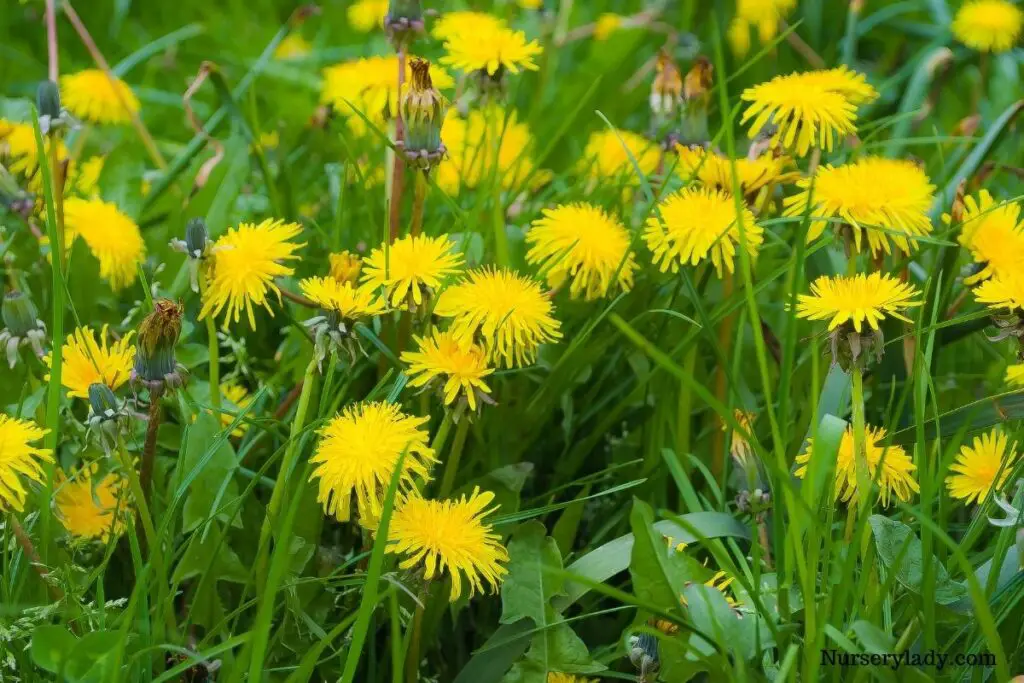
Dandelions are considered as weeds and removed from gardens. They are extremely loved amongst bees, and you will find them always buzzing around them. They are easy to grow and can thrive in almost all conditions. Add them to your herb garden or plant them in containers, as per your choice.
Sunlight: Dandelions can grow from low light to full sun. They will grow rapidly in full sun, for 8 hours and more. In low light, they may grow comparatively slow.
Watering: Water Dandelions when the soil is quite dry as they can tolerate some dryness. Never overwater and keep the soil evenly moist for better leafy productions.
Fertilizing: Dandelions are light feeders and will benefit from organic fertilizer or compost once in the year. You can also mix organic matter into the soil to improve its nutrition. If you wish to eat them, use organic fertilizer and avoid chemical fertilizers.
General care: Dandelions can tolerate temperatures below 50 degrees Fahrenheit. They prefer temperatures around 70 degrees Fahrenheit or more. They can thrive in low to high humidity.
Chives
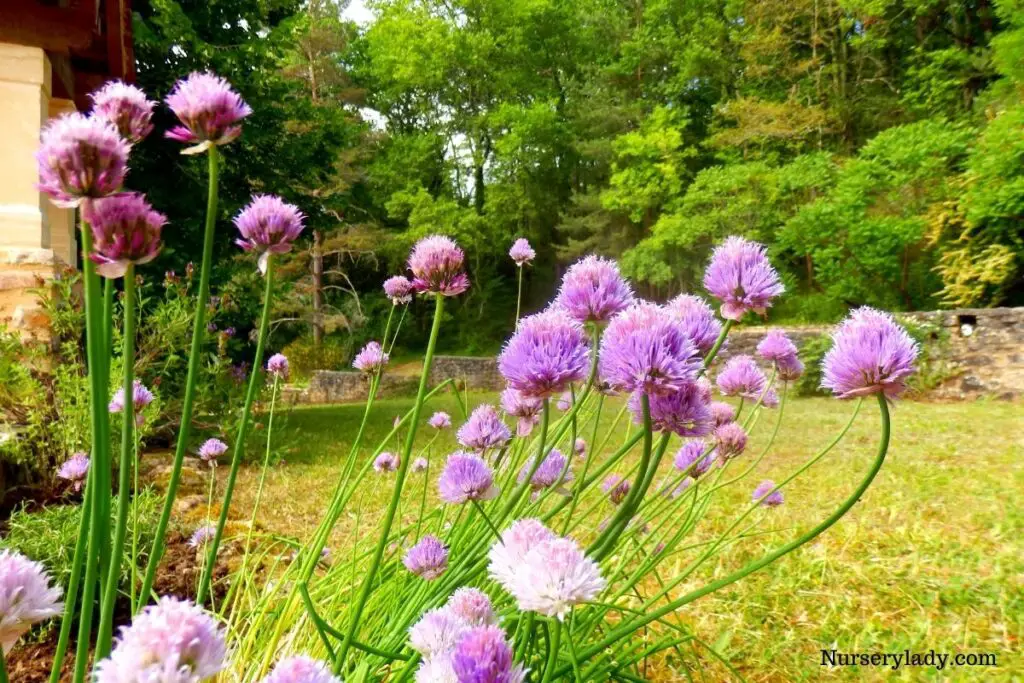
Chives are herbs that spread rapidly. They have pink and purple blooms, which bees and other pollinators love. They are easy to grow and even planted to repel some insects. They will grow year after year and have several uses in the kitchen.
Sunlight: Chives prefer sunny locations and will grow and bloom abundantly in full sun. In shade or low light, the growth and blooms will be less impressive. If the sun is too harsh, they would love some shade.
Watering: Chives like to be more on the drier side but water them when the soil is dry for a better harvest. Once established, you can skip some watering sessions but keep them evenly moist for better growth. Also, mulching can help retain soil moisture.
Fertilizer: Chives don’t need frequent feeding, but yes will achieve better growth by top dressing with a nitrogen-heavy fertilizer. Feeding in the late spring or early summer and avoid feeding during the dormant period.
General care: Chives are sensitive to extreme heat, and they can go dormant In the middle of the summer due to extreme heat. Also, protect them in freezing temperatures. Give them some warmth by keeping them near radiators, fireplaces, etc.
Thyme
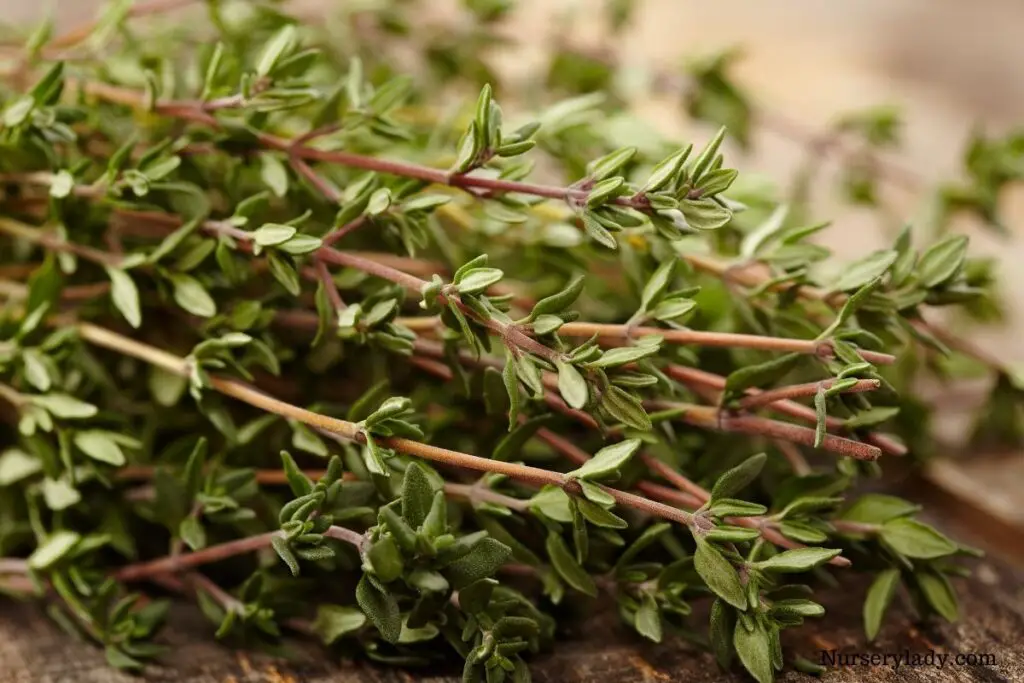
Thyme is a versatile herb that spreads easily to fill any space. They have small blooms that bees and other pollinators enjoy. Thyme needs little attention and can be controlled, unlike other herbs. Their stems can grow up to 12 inches tall in a year.
Sunlight: Thymes are sun-loving plants that would grow best in full sun. Keep them outdoors or near windowsills where they can receive bright light all day long. If there is low light available in your home, you can use grow lights; that will work too.
Watering: Water thyme when its soil is dry, and it’s okay to keep it under-watered instead of over-watered. Check the soil before watering to avoid sogginess.
Fertilizer: Thymes don’t need feeding to thrive; instead, they thrive in poor soil. You can feed it with a diluted fertilizer in the early spring if you wish. Feed with organic fertilizer as you want to eat this herb.
General care: Thyme likes hot and arid conditions. Maintain temperature levels between 60 degrees Fahrenheit to 80 degrees Fahrenheit. They prefer low humidity. High humidity may lead to fungal disease, etc.
Yarrow
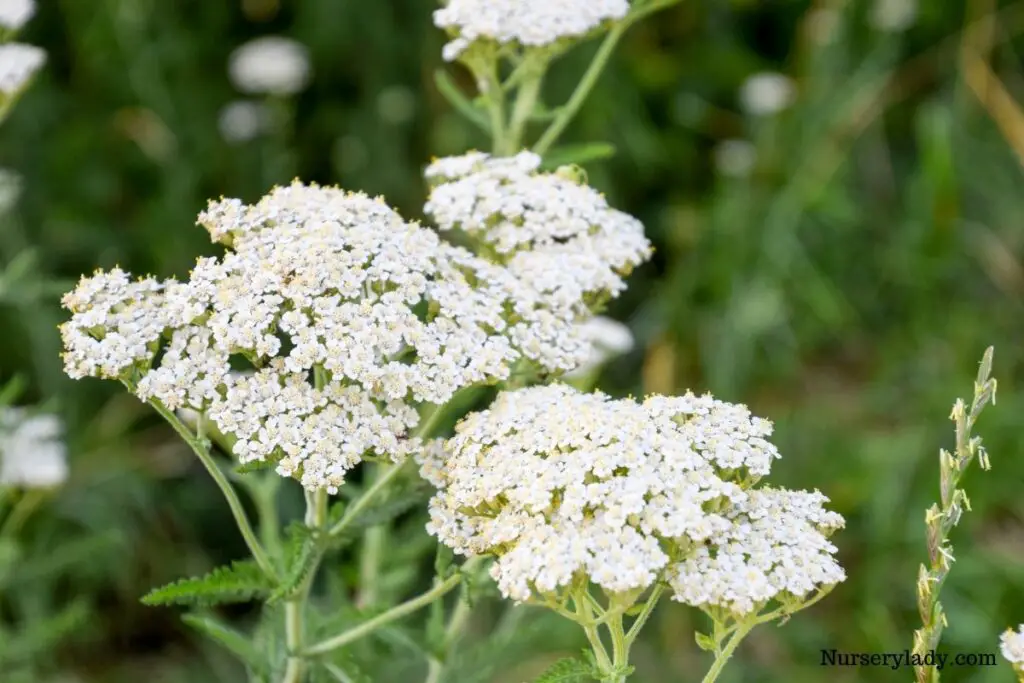
Yarrow has thick green foliage and yellow blooms. They can reach up to 3 feet high in their growing period, and they look perfect in ground covers, borders, etc. Bees and other pollinators buzz around to feed in its flowers.
Sunlight: Yarrow grows best in full sun but will grow in shaded areas too. In low light areas, they might not grow that strong and thin stems may need stakes to stay upright.
Watering: Water yarrow to keep the soil evenly moist in the first season to establish them. After that, they become drought-tolerant but water them in regular intervals when the soil is dry.
Fertilizer: Yarrow is a light feeder and can even thrive without any feeding. Side dressing with compost in the growing season will be enough. Rich soil or extra feeding can lead to the yarrow spreading aggressively.
General care: Yarrow appreciates hot and humid temperatures. Deadhead faded blooms in mid-summer to encourage the next blooming.
Honeysuckle
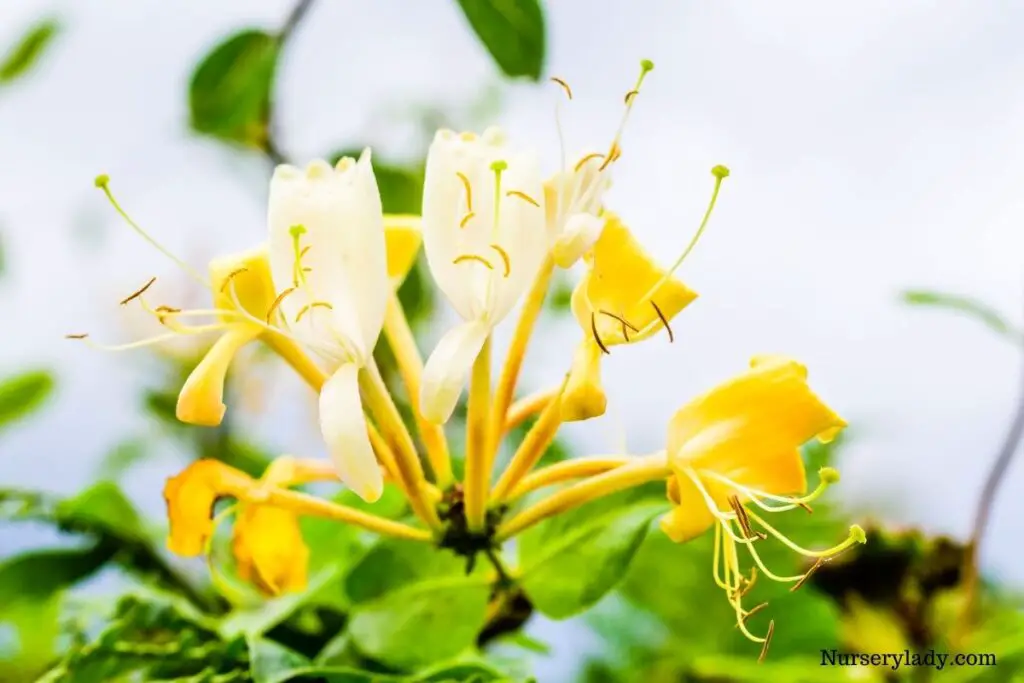
Honeysuckle is a fragrant evergreen shrub producing tubular blooms. They are in different colors like yellow, red, pink, white, or purple. They spread aggressively and are even prohibited in certain parts of the country. Bees, hummingbirds, etc, like to feed on their tubular flowers.
Sunlight: Honeysuckle enjoys dappled sun; they grow best from full sun to part shade. If you shade their roots and allow the plant to be exposed to the sun, they will grow their best.
Watering: Water young honeysuckle regularly to keep the soil evenly moist. It will allow them to establish strong roots. Once they show vigorous growth, water only when the soil is dry. They become drought-tolerant, and you can add mulch to allow water retention.
Fertilizer: Feed honeysuckle with low nitrogen fertilizer by diluting it to half the recommended strength. Low nitrogen will keep the foliage growth in check and allow better blooming. Also, if the soil is fertile, they can grow even without any feeding.
General care: Honeysuckle grows best in cool climates and may suffer in high heat. Prune them and remove dead twigs and branches regularly to save too much pruning. Use stakes to support young vines.
Lantana
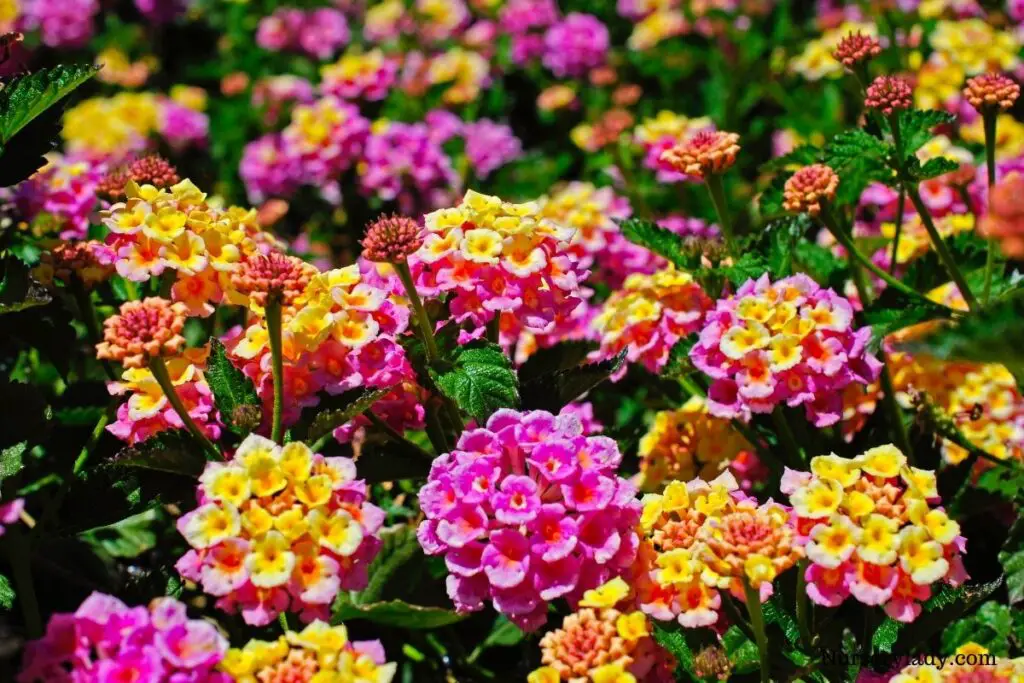
Lantana produces clusters of tiny flowers in pin red, white, yellow, orange, blue, or purple. They have textured leaves that have a citrusy fragrance. Their flowers are loved amongst pollinators like bees, hummingbirds, butterflies, etc. they are fast-growing and toxic to animals.
Sunlight: Lantana grows well when kept in partial sun or full sun for at least 6 hours. They can be kept in the shade, but if kept in low light or too much shade, it may inhibit their flowering.
Watering: Water lantana when the soil is halfway dry, keeps its soil evenly moist and never soggy. Watering properly will make them stronger and encourage blooming.
Fertilizer: Lantana are light feeders, and with too much fertilizing the flowering may reduce. They can be fed with a balanced fertilizer once in the spring and not more than that.
General care: Lantana prefers a temperature level around 55 degrees Fahrenheit and more. They can tolerate temperature levels as below as 28 degrees Fahrenheit. Keep them in a warm location in freezing temperatures. They like humid conditions.
Snapdragons
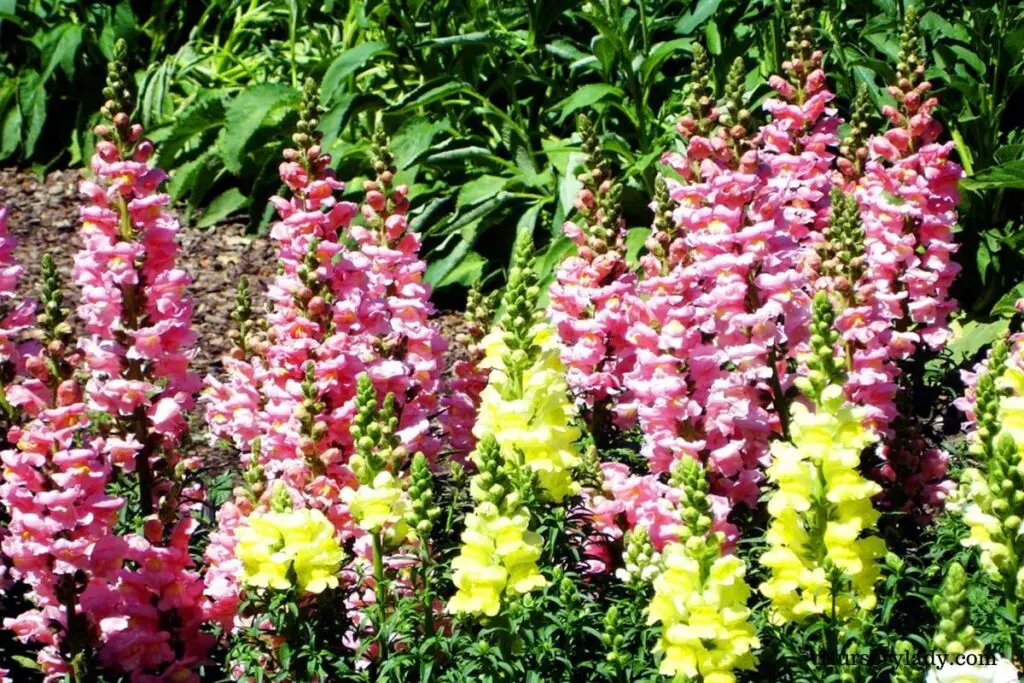
Snapdragons produce unique bell-shaped blooms in different colors like yellow, blue, due to which it becomes attractive to bees, hummingbirds, etc. They can grow well in baskets, containers, etc.
Sunlight: Snapdragons grow and bloom best in full sun, and they can grow well in partial shade too, but full sun is best. Keep them in partial shade in hot summers. In high heat, they stop flowering and bloom again in the fall.
Watering: Snapdragons like to be watered in regular intervals in the first season. When established, they need water when the soil is dry. Avoid overhead watering as it may lead to leaf diseases.
Fertilizer: Snapdragons are light feeders but fertilizing when they start producing flowers will encourage better blooming. Feed with balanced diluted fertilizer and water properly for proper fertilizer distribution.
General care: Snapdragons grow well in cool temperatures during the months of spring and fall. During the night, they prefer a temperature level around 40 degrees Fahrenheit and around 70 degrees Fahrenheit during the day. Add mulch to help them survive chilling temperatures.
Sedums
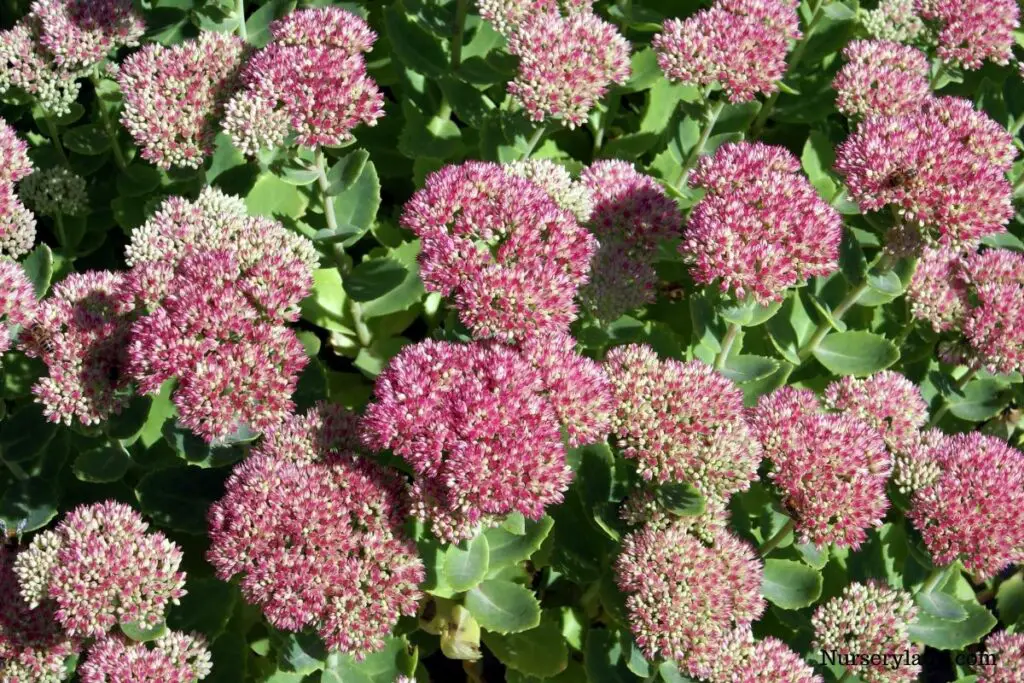
Sedums have thick, fleshy foliage in different shades and tiny flowers in several colors and forms. These sedums look great in containers, ground covers along borders, etc. They have a moderate growth rate and are reached by short-tongued bees easily.
Sunlight: Sedums like full sun exposure for best flowering and growth. Keep them in full sun to partial shade for 6-8 hours a day. Keep them in the shade if the afternoon sun is very strong.
Watering: Sedum when young needs water to stay evenly moist for establishing strong roots. You can water them sparingly once they have shown growth but avoid excess watering. Since they are drought tolerant and over watering will lead to fungal diseases.
Fertilizer: Sedums are light feeders but will appreciate some compost mixing if the soil is poor. They do not need too rich soil as it can even lead to weak and leggy plants.
General care: Sedums are hardy plants and can tolerate wide varieties for temperature levels. Temperature levels above 90 degrees Fahrenheit can scorch their leaves. Maintaining low to average humidity around them and well-draining soil is crucial.
Reference: The University of Minnesota, Kansas State University, BBC Wildlife Magazine, Arizona-Sonora Desert Museum.
